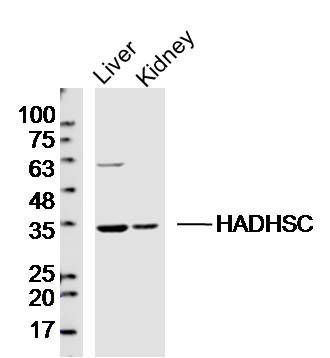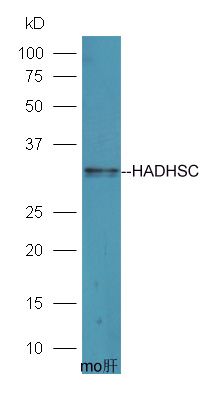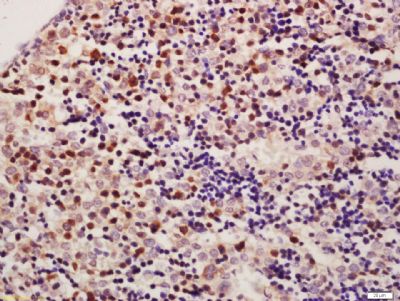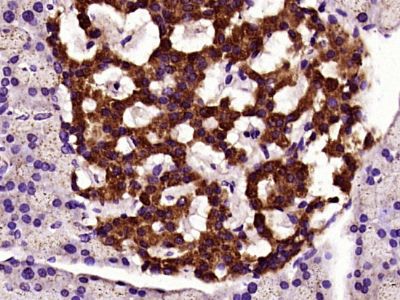产品中心
当前位置:首页>产品中心Anti-HADHSC
货号: bs-10020R 基本售价: 1380.0 元 规格: 100ul
- 规格:100ul
- 价格:1380.00元
- 规格:200ul
- 价格:2200.00元
产品信息
- 产品编号
- bs-10020R
- 英文名称
- HADHSC
- 中文名称
- 短链L-3羟烷基辅酶A脱氢酶抗体
- 别 名
- HAD; HADH; HADH1; HADHSC; HCDH; HCDH_HUMAN; HHF4; Hydroxyacyl CoA dehydrogenase; Hydroxyacyl-coenzyme A dehydrogenase; hydroxyacyl-coenzyme A dehydrogenase, mitochondrial; L 3 hydroxyacyl Coenzyme A dehydrogenase short chain; M SCHAD; Medium and short chain L 3 hydroxyacyl coenzyme A dehydrogenase; Medium and short-chain L-3-hydroxyacyl-coenzyme A dehydrogenase; MGC8392; mitochondrial; MSCHAD; OTTHUMP00000162626; OTTHUMP00000219688; SCHAD; Short chain 3 hydroxyacyl CoA dehydrogenase mitochondrial; short chain 3-hydroxyacyl-coa dehydrogenase; Short-chain 3-hydroxyacyl-CoA dehydrogenase.
- 规格价格
- 100ul/1380元购买 200ul/2200元购买 大包装/询价
- 说 明 书
- 100ul 200ul
- 研究领域
- 肿瘤 细胞生物 信号转导 激酶和磷酸酶 糖尿病 新陈代谢 线粒体
- 抗体来源
- Rabbit
- 克隆类型
- Polyclonal
- 交叉反应
- Human, Mouse, Rat, Pig, Cow,
- 产品应用
- WB=1:500-2000 ELISA=1:500-1000 IHC-P=1:400-800 IHC-F=1:400-800 ICC=1:100-500 IF=1:100-500 (石蜡切片需做抗原修复)
not yet tested in other applications.
optimal dilutions/concentrations should be determined by the end user.
- 分 子 量
- 33kDa
- 细胞定位
- 细胞浆 线粒体
- 性 状
- Lyophilized or Liquid
- 浓 度
- 1mg/ml
- 免 疫 原
- KLH conjugated synthetic peptide derived from human HADHSC:241-314/314
- 亚 型
- IgG
- 纯化方法
- affinity purified by Protein A
- 储 存 液
- 0.01M TBS(pH7.4) with 1% BSA, 0.03% Proclin300 and 50% Glycerol.
- 保存条件
- Store at -20 °C for one year. Avoid repeated freeze/thaw cycles. The lyophilized antibody is stable at room temperature for at least one month and for greater than a year when kept at -20°C. When reconstituted in sterile pH 7.4 0.01M PBS or diluent of antibody the antibody is stable for at least two weeks at 2-4 °C.
- PubMed
- PubMed
- 产品介绍
- background:
This gene is a member of the 3-hydroxyacyl-CoA dehydrogenase gene family. The encoded protein functions in the mitochondrial matrix to catalyze the oxidation of straight-chain3-hydroxyacyl-CoAs as part of the beta-oxidation pathway. Its enzymatic activity is highest with medium-chain-length fatty acids. Mutations in this gene cause one form of familial hyperinsulinemic hypoglycemia. The human genome contains a related pseudogene of this gene on chromosome 15. [provided by RefSeq.]
Function:
Plays an essential role in the mitochondrial beta-oxidation of short chain fatty acids. Exerts it highest activity toward 3-hydroxybutyryl-CoA.
Subunit:
Homodimer.
Subcellular Location:
Mitochondrion matrix.
Tissue Specificity:
Expressed in liver, kidney, pancreas, heart and skeletal muscle.
DISEASE:
Defects in HADH are the cause of 3-alpha-hydroxyacyl-CoA dehydrogenase deficiency (HADH deficiency) [MIM:231530]. HADH deficiency is a metabolic disorder with various clinical presentations including hypoglycemia, hepatoencephalopathy, myopathy or cardiomyopathy, and in some cases sudden death.
Defects in HADH are the cause of familial hyperinsulinemic hypoglycemia type 4 (HHF4) [MIM:609975]; also known as persistent hyperinsulinemic hypoglycemia of infancy (PHHI) or congenital hyperinsulinism. HHF is the most common cause of persistent hypoglycemia in infancy and is due to defective negative feedback regulation of insulin secretion by low glucose levels. It causes nesidioblastosis, a diffuse abnormality of the pancreas in which there is extensive, often disorganized formation of new islets. Unless early and aggressive intervention is undertaken, brain damage from recurrent episodes of hypoglycemia may occur. HHF4 should be easily recognizable by analysis of acylcarnitine species and that this disorder responds well to treatment with diazoxide. It provides the first experiment of nature that links impaired fatty acid oxidation to hyperinsulinism and that provides support for the concept that a lipid signaling pathway is implicated in the control of insulin secretion.
Similarity:
Belongs to the 3-hydroxyacyl-CoA dehydrogenase family.
SWISS:
Q16836
Gene ID:
3033
Database links:Entrez Gene: 3033 Human
Entrez Gene: 15107 Mouse
Entrez Gene: 113965 Rat
Omim: 601609 Human
SwissProt: Q16836 Human
SwissProt: Q61425 Mouse
SwissProt: Q9WVK7 Rat
Unigene: 438289 Human
Unigene: 260164 Mouse
Unigene: 92789 Rat
Important Note:
This product as supplied is intended for research use only, not for use in human, therapeutic or diagnostic applications.
- 产品图片
 Sample:
Sample:
Liver (Mouse) Lysate at 40 ug
Kidney (Mouse) Lysate at 40 ug
Primary: Anti- HADHSC (bs-10020R) at 1/300 dilution
Secondary: IRDye800CW Goat Anti-Rabbit IgG at 1/20000 dilution
Predicted band size: 33 kD
Observed band size: 33 kD Sample: Liver (Mouse) Lysate at 40 ug
Sample: Liver (Mouse) Lysate at 40 ug
Primary: Anti-HADHSC (bs-10020R) at 1/300 dilution
Secondary: HRP conjugated Goat-Anti-rabbit IgG (bs-0295G-HRP) at 1/5000 dilution
Predicted band size: 33 kD
Observed band size: 33 kD Tissue/cell: mouse fetal liver; 4% Paraformaldehyde-fixed and paraffin-embedded;
Tissue/cell: mouse fetal liver; 4% Paraformaldehyde-fixed and paraffin-embedded;
Antigen retrieval: citrate buffer ( 0.01M, pH 6.0 ), Boiling bathing for 15min; Block endogenous peroxidase by 3% Hydrogen peroxide for 30min; Blocking buffer (normal goat serum,C-0005) at 37℃ for 20 min;
Incubation: Anti-HADHSC Polyclonal Antibody, Unconjugated(bs-10020R) 1:200, overnight at 4°C, followed by conjugation to the secondary antibody(SP-0023) and DAB(C-0010) staining Paraformaldehyde-fixed, paraffin embedded (Rat pancreas); Antigen retrieval by boiling in sodium citrate buffer (pH6.0) for 15min; Block endogenous peroxidase by 3% hydrogen peroxide for 20 minutes; Blocking buffer (normal goat serum) at 37°C for 30min; Antibody incubation with (HADHSC) Polyclonal Antibody, Unconjugated (bs-10020R) at 1:400 overnight at 4°C, followed by operating according to SP Kit(Rabbit) (sp-0023) instructionsand DAB staining.
Paraformaldehyde-fixed, paraffin embedded (Rat pancreas); Antigen retrieval by boiling in sodium citrate buffer (pH6.0) for 15min; Block endogenous peroxidase by 3% hydrogen peroxide for 20 minutes; Blocking buffer (normal goat serum) at 37°C for 30min; Antibody incubation with (HADHSC) Polyclonal Antibody, Unconjugated (bs-10020R) at 1:400 overnight at 4°C, followed by operating according to SP Kit(Rabbit) (sp-0023) instructionsand DAB staining.

